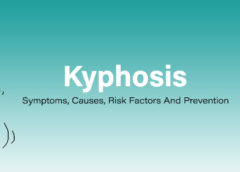What is kyphosis?
When viewed from the side the spine has a series of normal curves. These curves help to withstand loads of the bodyweight added to the spine. The cervical spine (neck) and lumbar spine (lower back) have a normal inward curvature called lordosis or lordotic curvature by health care professionals, by which the spine is bent backward. The thoracic spine (top back) has a normal outward curvature which is named by health care providers Kyphosis- Symptoms, Causes, Risk Factors, and Prevention
Kyphosis or the kyphotic curve that bends the spine inward. Hyper kyphosis is the official medical term for abnormal curvature of the thoracic spine. However, the medical community commonly calls abnormal kyphosis and hyperkyphosis kyphosis, so the term kyphosis will be used to discuss abnormal kyphosis in this discussion. Kyphosis is, in other words, a deformity of the upper back spine that creates an exaggerated outward curve.
Normally the spine is straight when seen from the front. Scoliosis is an abnormal curve when viewed from the front. Scoliosis may occur as a result of bony abnormalities of the spine at birth, growth abnormalities especially in adolescence, degenerative spinal changes in adulthood, or after an injury an abnormal vertebra twisting due to muscle spasm.
The normal spine curves allow the head to balance directly above the pelvic. If one or more of these curves is either too great or too small, the head may not properly balance over the pelvis. It can lead to back pain, stiffness, and an altered style of gait or walking.
What are the symptoms of kyphosis?
Most people with kyphosis have no symptoms other than rounded shoulders in the upper back hump. The bigger the curve, the more likely the person will develop other symptoms. These can include:
- Pain or stiffness in the back and/or shoulder blades.
- Numb, weak, or tingling legs.
- Extreme fatigue.
- Poor posture.
- Shortness of breath or other breathing difficulties.
When to seek treatment for kyphosis
Seek treatment if your kyphosis is accompanied by:
- Pain
- Breathing Difficulties
- Fatigue
Much of our body movement depends on the spine’s health including our:
- Flexibility
- Mobility
- Activity
Getting treatment to help correct the curvature of your spine may help you reduce the risk of complications later in life, including arthritis and back pain.
What causes kyphosis?
During kyphosis, the normal curve becomes more pronounced than usual in the middle part of the vertebral column (the thoracic vertebrae). There are several reasons for that, including:
Poor posture (postural kyphosis) – slouching, leaning back in the chairs, and carrying heavy bags can stretch muscles and ligaments that can increase the curvature of the spinal cord
Abnormally shaped (Scheuermann’s kyphosis) vertebrae – if the vertebrae do not develop properly, they may end up out of position
Abnormal spine formation in the womb (congenital kyphosis)-if anything disrupts the normal development of the spine, often two or more vertebrae fuse
Age – As people get older they can increase their spinal curvature
Also, kyphosis may develop from a spinal injury.
Risk factors
Below are the risk factors that predispose kyphosis to develop –
- Osteoporosis
- Disk degeneration such as arthritis
- Ankylosing spondylitis
- Connective tissue disorders such as Marfan syndrome
- Muscular dystrophy
- Neurofibromatosis
- Paget’s disease
- Polio
- Spina tuberculosis
- Spina tumors
- Spina bifida
- Scoliosis
- Trauma
- Poor posture of teenagers
Complications
Apart from causing back pain, kyphosis can cause:
- Breathing problems: Severe kyphosis can put pressure on the lungs.
- Limited physical functions. Kyphosis is linked to weakened back muscles and difficulty in doing tasks such as walking and getting out of chairs. The curvature of the spinal cord can also make it difficult to look upwards or drive, and when you lie down can cause pain.
- Digestive problems: Serious kyphosis can compress the digestive tract causing problems like acid reflux and swallowing difficulties
- Body image problems: Kyphosis patients, particularly teenagers, can develop poor body image from having a rounded back or brace to correct the condition. Bad body image can contribute to social isolation for older people.
Prevention
Sometimes people can prevent cases of kyphosis by maintaining good posture and a healthy back. Tips for preventing kyphosis include:
- Exercising regularly
- Avoiding slouching
- Using orthopedic equipment when using a desk, or computer
- Using well-designed backpacks that spread the weight evenly across the back

Leave a Reply
You must be logged in to post a comment.